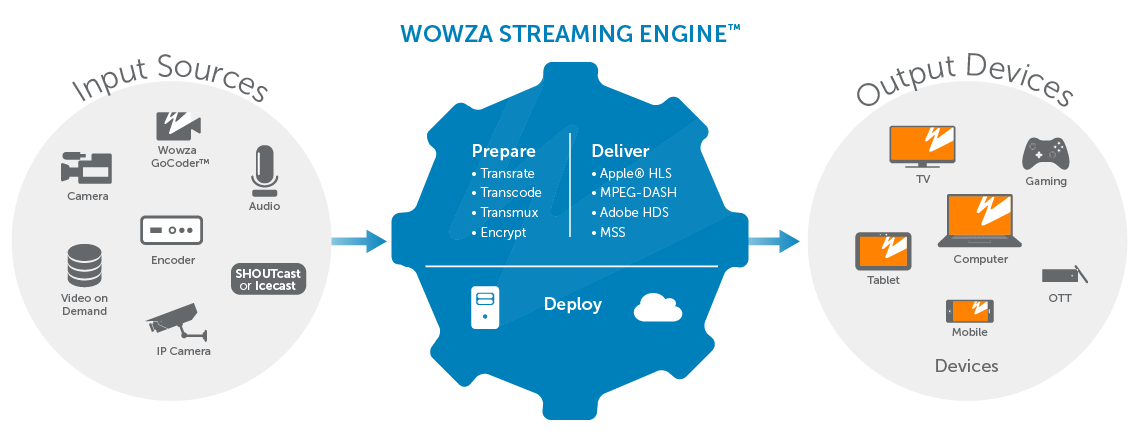Streaming Protocols and Latency

Streaming protocols directly impact the latency of your streams. Depending on whether you’re using WebRTC or Apple HLS, video lag could fall anywhere between 1 and 45 seconds. Learn why this disparity occurs and how to select the right protocol for your streaming solution.
Latency Across Streaming Protocols
Today’s audiences demand real-time video delivery. When it comes to high-stakes sporting events and online gaming, low latency is crucial.
How can you accommodate users? Selecting the right streaming protocol is a good place to start.
That’s because different protocols determine latency, stream quality, and playback across devices. While HTTP-based protocols deliver a great user experience, other protocols are a better fit for real-time interactivity. There’s are also a handful of emerging technologies like Secure Reliable Transport (SRT), Common Media Application Format (CMAF), and Web Real-Time Communications (WebRTC) that can be used as alternatives to traditional protocols.
What’s the right protocol for your use case? Let’s break it down.
What Is Video Latency?
Latency is the delay between when a frame of video is captured and displayed for playback. Also called video lag, this is measured by the time it takes to get a live broadcast from the camera’s lens to a viewer’s screen.
What Is a Streaming Protocol?
A protocol is a set of rules governing how data travels from one device to another. For instance, the Hypertext Transfer Protocol (HTTP) deals with hypertext documents and webpages.
Online video delivery uses both streaming protocols and HTTP-based protocols. Streaming protocols like Real-Time Messaging Protocol (RTMP) offer fast video delivery, whereas HTTP-based protocols can help optimize the viewing experience.

Traditional Low-Latency Streaming Protocols
Traditional streaming protocols such as RTSP and RTMP support low-latency streaming. But they aren’t supported on all endpoints (e.g., iOS devices). These work best for streaming to a small audience from a single media server.
As shown above, RTMP delivers video at roughly the same pace as a cable broadcast — in just over five seconds. RTSP streams are even faster, taking just over a second from screen to screen.
HTTP-Based Adaptive Streaming Protocols
Protocols such as HLS, HDS, HSS and MPEG-DASH are best for streaming to large audiences. Using adaptive bitrate streaming, these protocols deliver the best video quality and viewer experience possible — no matter the connection, software, or device.
That said, HTTP-based protocols fall on the high end of the latency spectrum at almost 45 seconds. Content distributors can tune HLS and DASH for speedier video delivery, but the latency will remain north of five seconds.
Because HTTP-based protocols don’t support ultra-low latency or real-time streaming, they’re ill-suited for chat or interactivity.
Emerging Protocols for Near-Real-Time Delivery
Emerging technologies like WebRTC, Low-Latency HLS, and CMAF support near-real-time delivery — even over poor connections. These technologies allow for a high degree of interactivity and playback quality.
Creating WebRTC, Low-Latency HLS, and CMAF streams is easy with a tool like the Wowza Streaming Engine™ software. We were among the first streaming providers to support Low-Latency HLS, and continue to add WebRTC enhancements to Wowza Streaming Engine.
Delivering Low-Latency Streams Across the Globe
Distance is also important. The farther your viewers are from the media server, the longer it will take to distribute a stream. This can cause buffering and latency.
Many broadcasters solve for this with a content delivery network (CDN). CDNs create superhighways of connected servers, thereby reducing the time it takes to deliver video streams from origin to end user. They also improve scalability as viewership increases.
We offer the Wowza CDN in partnership with Akamai. This is automatically included with the Wowza Streaming Cloud™ service.
Selecting the Right Protocol for Playback
In addition to latency, playback compatibility is worth considering when selecting a protocol. Legacy devices and browsers only accept legacy file formats.
Reaching the broadest audience possible starts with accommodating additional video formats.
By transcoding the stream into a variety of formats, you can ensure video scalability no matter the device. We suggest delivering video across a variety of formats — including MPEG-DASH, Apple HLS, and WebRTC.

End-to-End Streaming Solutions
Live video streaming starts with the right tools. With viewers across the globe on a variety of platforms, it’s worth considering how you’re going to package and transport content. In addition to reducing latency, you may want to increase stream compatibility or improve the streaming experience across devices.
Transcoding streams into the right protocols is key. Curious how it works? Watch our video to learn more or get started with a free trial.




